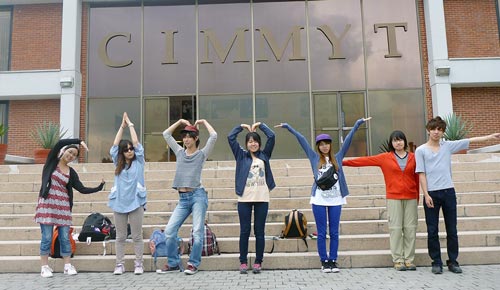Mathematical models could boost CIMMYT’s impact on Mexico, a leading scientist in the United States said last month. Carlos Castillo-Chavez, a Mexican-born scientist and professor at Arizona State University, visited El Batán from 21 to 23 August to meet with the staff of the MasAgro program and the Biometrics and Statistics Unit. His trip focused on learning about and giving input on CIMMYT programs as well as seeking opportunities for collaboration with ASU.
Castillo-Chavez is part of U.S. President Barack Obama’s Committee on the National Medal of Science, whose members help select medal candidates from among top U.S. scientists. Castillo-Chavez grew up in Mexico City with interests in theater and literature but thought he would be more successful pursuing math. He moved to the United States in 1974 and worked odd jobs before starting college in Wisconsin and later earning a PhD in mathematics from the University of Wisconsin- Madison. He first visited CIMMYT about two decades ago and was the PhD adviser at Cornell University for Carlos Hernández, the head of CIMMYT’s Biometrics and Statistics Unit. Castillo-Chavez’s research focuses on the intersection between math, natural sciences, and social sciences. He studies disease evolution and social landscapes, including tuberculosis and SARS, the role of mass transit systems in the spread of influenza in Mexico, and “social diseases” such as drinking and drug use. Castillo- Chavez founded the Mathematical, Computational and Modeling Sciences Center at ASU and has received various awards at the national level for his research, teaching, and mentorship of minority students.
Bringing research to the people it could benefit is often a complicated and political process, Castillo- Chavez said. Scientists have the responsibility to communicate their research to the public, but policymakers set the course for “trendy” research topics. It’s an issue that needs to change, he said. And it could change with more interdisciplinary programs that have direct ties to and benefits for society. “Most problems of interest to Mexico don’t always apply to what’s current or hot in international academia,” Castillo- Chavez said. “There is no reason why Mexico should not have its own research agenda that may or may not intersect with the U.S.” He said during the visit that his research on contagion and how information spreads applies to the work CIMMYT is doing. Mathematical models can be used to study and increase the impact CIMMYT’s research has on Mexico by assessing the culture and identifying obstacles, he said. By communicating the research to enough people, “a culture change takes place where farmers and politicians are in constant communication to implement CIMMYT research,” Castillo- Chavez said. ASU and CIMMYT’s Biometrics and Statistics Unit could collaborate on this research by mentoring and training young people who would work closely with both institutions, he said, adding that he’s interested in exploring those possibilities.
During his visit, Castillo-Chavez learned MasAgro is an example of a project that targets a local population, he said. But the challenge with all advancements is finding the right leaders to put them into place. “It’s clear the research could generate dramatic improvements if implemented,” he said. “Nationally, we would see incredible advances in sustainable agriculture.”

 Capacity development
Capacity development 